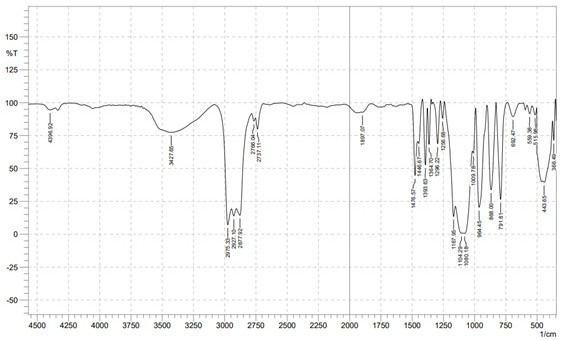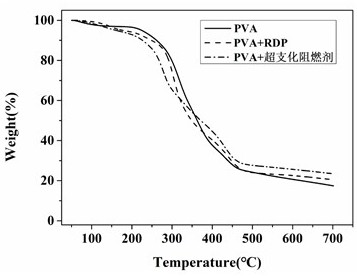Hyperbranched phosphorus-containing oxygen group functionalized silicon-based resin flame retardant and preparation method thereof
A phosphorus-oxygen-functional, silicon-based resin technology, applied in the field of flame retardants, can solve the problems of flame retardant efficiency, heat resistance and water washing resistance that are not as good as bromine antimony flame retardant systems, etc.
- Summary
- Abstract
- Description
- Claims
- Application Information
AI Technical Summary
Problems solved by technology
Method used
Image
Examples
Embodiment 1
[0043] In one embodiment of the present invention, in step (1), tetraethoxysilane is used as a silane compound having three or more condensable functional groups, and neopentyl glycol is used as a hydroxyl-containing compound. Controlling the molar ratio of condensable ethoxy functional groups in tetraethoxysilane to neopentyl glycol hydroxyl groups in the range of 1.2:1 to 4.0:1, preferably greater than 1.2:1 to 3.0:1 , more preferably in the range of 1.5:1 to 2.5:1, most preferably 2:1 into the reactor. Stirring is carried out at a high temperature of 120-180°C in the absence of catalysts and solvents, and the reaction is carried out for 5-20 hours. In order to increase the reaction rate, a catalyst such as p-toluenesulfonic acid, and a solvent such as xylene may also be used in appropriate amounts.
[0044] While not wishing to be bound by any theory, the inventors believe that tetraethoxysilane and neopentyl glycol react in the examples as represented by Scheme A below: ...
Embodiment 2
[0052] In one embodiment of the present invention, in step (1), tetraethoxysilane is used as a silane compound having three or more condensable functional groups, and neopentyl glycol and trimethylolpropane are used as hydroxyl-containing compounds. The molar ratio of the condensable ethoxy group of tetraethoxysilane to the hydroxyl group in neopentyl glycol and trimethylolpropane is controlled in the range of 1:1.2 to 1:4, preferably 1:1.4 to 1: 2.5, more preferably in the range of 1:1.5 to 1:2.0, into the reactor. In the absence of catalysts and solvents, stirring is carried out at a high temperature of 120-180° C., and the reaction is carried out for 5-20 hours. In order to increase the reaction rate, catalysts (such as p-toluenesulfonic acid) and solvents (such as xylene) can also be used in appropriate amounts.
[0053] Although not wishing to be bound by any theory, the inventors believe that tetraethoxysilane reacts with neopentyl glycol and pentaerythritol according t...
Embodiment 3
[0061] Step (1) Add 208.33g (1.00mol) of tetraethoxysilane and 374.94g (3.60mol) of neopentyl glycol to four ports equipped with thermometer, top stirrer, gas inlet and distillation device at room temperature in the flask. The reaction was carried out under the protection of a stream of anhydrous nitrogen introduced through the gas inlet of the reactor. The reaction mixture was then heated to 115°C and maintained at this temperature until distillate distilled from the reaction mixture. Heating was continued and the temperature of the reaction mixture was gradually increased to 180° C. until the ethanol was distilled off completely. In this way, hyperbranched polysiloxanes containing hydroxyl groups are obtained.
[0062] Step (2) Weigh 613.32g (1.60mol) of phosphorus oxychloride and place it in a constant pressure dropper, install it on the three-necked flask containing hydroxyl-containing hyperbranched polysiloxane obtained in step 3, and pour it into the three-necked flask...
PUM
 Login to View More
Login to View More Abstract
Description
Claims
Application Information
 Login to View More
Login to View More - R&D
- Intellectual Property
- Life Sciences
- Materials
- Tech Scout
- Unparalleled Data Quality
- Higher Quality Content
- 60% Fewer Hallucinations
Browse by: Latest US Patents, China's latest patents, Technical Efficacy Thesaurus, Application Domain, Technology Topic, Popular Technical Reports.
© 2025 PatSnap. All rights reserved.Legal|Privacy policy|Modern Slavery Act Transparency Statement|Sitemap|About US| Contact US: help@patsnap.com



